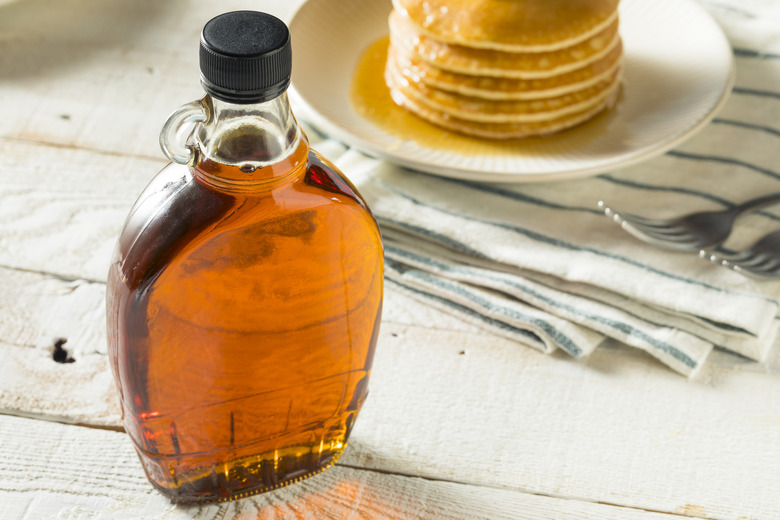FDA To Revise 'Added Sugar' Labels On Maple Syrup And Honey
Do pure honey and maple syrup have "added sugars"? The idea might sound a little odd, since the two sweet products are naturally made up mostly of sugar, but the Food and Drug Administration rolled out a new nutrition label a couple of years ago that would require these products to say they contain 'added sugars' when they actually do not, manufacturers and dieticians argue.
Now, the FDA is reconsidering that proposed requirement and may allow manufacturers to continue labeling them as having zero added sugars.
This sweet saga began in 2016 when the federal agency rolled out a new "Nutrition Facts" labeling system that distinguished between "sugars" and "added sugars." The change, which was due to be required by 2020 in most cases, was said to "reflect new scientific information" and "make it easier for consumers to make better informed food choices." Government dietary guidelines recommend that no more than 10 percent of daily calories come from added sugars.
"When the FDA refers to 'added sugars,' they are referring to sugars that have been added to a food and are not naturally found in the food," explained clinical dietitian and adjunct professor Cheryl Mussatto to The Daily Meal in an email. Mussatto says that these generally include ingredients such as brown sugar, corn sweetener, corn syrup, high-fructose corn syrup, dextrose, fructose, fruit juice concentrates, glucose, invert sugar, lactose, maltose, malt syrup, molasses, raw sugar, sucrose, and turbinado sugar.
"If honey and maple syrup are added to a food that naturally does not contain them, then they are considered an 'added sugar,'" Mussatto explained. "But honey and maple syrup do not contain any sugars that have been added to them."
The problem for manufactuers (and consumers confused by this change) is that the existing FDA proposal denotes all honey and maple syrup as "added sugars." Therefore, all the sugar in bottles of pure honey and maple syrup must appear as grams of "added sugar" on the label. Some products carry this confusing label already while others do not, since the change is not required until the label regulations go into effect in a couple of years.
Earlier this year, the FDA acknowledged the confusion these labels might create and asked for public comments on the draft guidance for the label regulations. More than 3,000 comments were received, and in a press release issued June 19 the agency acknowleged that their draft guidance "does not provide the clarity that the FDA intended" for pure honey and maple syrup, as well as certain cranberry products.
"It is important to FDA that consumers are able to effectively use the new Nutrition Facts label to make informed, healthy dietary choices," the press release said. "The agency looks forward to working with stakeholders to devise a sensible solution."
Maple syrup producers have been advocating for the change, asserting that the new label is misleading since they do not add any additional sugars or other ingredients to their pure maple syrup. Many other syrup products — such as Aunt Jemima — are formulated from corn syrup along with flavorings, color, and other additives.
"Pure maple syrup and honey are considered natural sweeteners and are often used as an alternative to table sugar or sugar substitutes for sweetening many foods," said Mussatto. "The average American consumes about 13 percent of their total calories from added sugars. The major sources of this extra sugar mainly come from low-nutrient sugary beverages (soft drinks, fruit drinks, etc.)."
The American Honey Producers Association told The Associated Press that the plan could "lead to consumers wondering what's being added to pure honey, when nothing is." Honey is naturally made up mostly of sugar — sugar isn't added to it.
"The primary goal of the FDA in proposing this was educating consumers to have no more than 10 percent of their daily calories from added sugar," registered dietitian Jackie Arnett Elnahar told The Daily Meal over email. "A consumer buying honey or maple syrup generally understands that honey and maple syrup are of high sugar content. It might be best to look into rephrasing it to 10 percent of daily calories from added sugar and high-sugar-content items, since many singular items (such as honey and maple syrup) should still be evaluated by Americans when trying to stay under 10 percent of daily calories for sugar — even if that sugar isn't technically added."
So even if honey and maple syrup don't have an "added sugar" label, you may still want to limit your consumption of them. Here's what more nutritionists had to say about the different types of sugar and when you should eat them.
